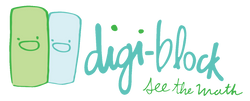Introduction
As children grow, they start trying to understand the relative size of things that they see. A toddler may think that a person and a house are about the same size. As children get older, they may understand that some things are bigger than others, but not have a good understanding of the relative size. An exercise that can be informative to children with both understanding of numbers and understanding of sizes is to use blocks for size estimation. Click here to see the interactive lesson demo. Pull the slider to see how tall a pencil, a child, a house and even the empire state building is in blocks!
![]()
Overview
For this activity, you will want a few items which have sizes that are easily understood by children. Some nearby examples may be a pencil, a book, and a friend. For each item, ask each child to estimate the height of the item in blocks and write down their estimates. The children may not yet have a sense of how to estimate, so a little guidance on how to estimate will likely be needed. One of the easiest ways to understand estimation is to work the children through multiplication and division– without telling them that’s what they’re doing! It can also help with understanding of base 10. For the smaller items that they will measure, get them to hold a block next to the item and ask them to write down how many blocks they think it would take to be as long as the item. Then, have them estimate how tall the larger items are compared to the small item.
Step by Step Instructions
- Have the child hold a pencil next to a block.
- Ask them to guess (without measuring) how many blocks long the pencil is and write the number of blocks for a pencil.
- Next, have the child hold the pencil next to the book and ask them to guess how many pencils long is the book and write the number of pencils for a book.
- Have the child hold the book next to their friend. (No hitting! :) )
- Have them guess how many books tall is their friend and write the number of books for a friend.
Then have them count the blocks that the estimated for a pencil, and have them put the pencil blocks into holders. When they have finished filling the tens holders, tell them that if the last tens holder is more than half-way full to fill it up and if it is less than half-way full to put put it back in the pile (rounding!). Then have them put the groups of tens blocks together for books and gather as many tens blocks for the book that they estimated is the height of the friend in books and count them (multiplication!).
Next have the children get in groups of two to four so that they can share materials and have a friend to measure. After they measure each item, have them write down the height of the item in blocks so that they can compare their estimates to their measurements.
Reflection
After that, you can share with them more items from this webpage to get a better understanding of how tall many different items are. Ask the children to reflect on why multiplication is such a useful operation when estimating incrementally larger objects. See all the items we measured in blocks!
Leave a comment with what objects you used in your lessons!

0 comments